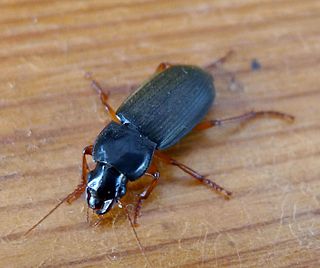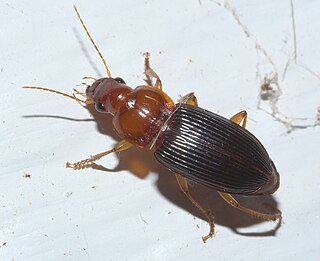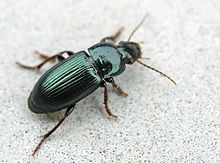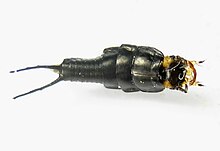
Tiger beetles are a family of beetles, Cicindelidae, known for their aggressive predatory habits and running speed. The fastest known species of tiger beetle, Rivacindela hudsoni, can run at a speed of 9 km/h, or about 125 body lengths per second. As of 2005, about 2,600 species and subspecies were known, with the richest diversity in the Oriental (Indo-Malayan) region, followed by the Neotropics. While historically treated as a subfamily of ground beetles (Carabidae) under the name Cicindelinae, several studies since 2020 indicated that they should be treated as a family, the Cicindelidae, which are a sister group to Carabidae within the Adephaga.

Franco Andrea Bonelli was an Italian ornithologist, entomologist and collector.

Ground beetles are a large, cosmopolitan family of beetles, the Carabidae, with more than 40,000 species worldwide, around 2,000 of which are found in North America and 2,700 in Europe. As of 2015, it is one of the 10 most species-rich animal families. They belong to the Adephaga. Members of the family are primarily carnivorous, but some members are herbivorous or omnivorous.

Amara is a large genus of carabid beetles, commonly called the sun beetles. Many are holarctic, but a few species are neotropical or occur in eastern Asia.

The Adephaga are a suborder of beetles, and with more than 40,000 recorded species in 10 families, the second-largest of the four beetle suborders. Members of this suborder are collectively known as adephagans. The largest family is Carabidae which comprises most of the suborder with over 40,000 species. Adephaga also includes a variety of aquatic beetles, such as predaceous diving beetles and whirligig beetles.

Ant nest beetles or paussines, some members of which are known also as flanged bombardier beetles, are a large subfamily within the ground beetles (Carabidae).The tribes Metriini, Ozaenini, Paussini and Protopaussini are included in the subfamily.

Dryptinae is a subfamily of ground beetles in the family Carabidae. There are more than 30 genera and 570 described species in Dryptinae.

Lebiinae is a subfamily of ground beetles in the family Carabidae. There are more than 330 genera and 6,300 described species in Lebiinae, in 5 tribes.

Pterostichinae is a subfamily of ground beetles. It belongs to the advanced harpaline assemblage, and if these are circumscribed sensu lato as a single subfamily, Pterostichinae are downranked to a tribe Pterostichini. However, as the former Pterostichitae supertribe of the Harpalinae as loosely circumscribed does seem to constitute a lineage rather distinct from Harpalus, its core group is here considered to be the present subfamily and the Harpalinae are defined more narrowly.
Rhysodinae is a subfamily in the family Carabidae. There are 19 genera and at least 380 described species in Rhysodinae. The group of genera making up Rhysodinae had been treated as the family Rhysodidae in the past, and subsequent DNA analysis then placed it within Carabidae, where it was sometimes treated as the tribe Rhysodini, but the most recent analyses place it as a subfamily in a clade along with subfamilies Paussinae and Siagoninae, forming a sister to the remaining Carabidae.

Trechinae is a subfamily of ground beetles in the family Carabidae. There are 6 tribes, more than 430 genera, and over 6,700 described species in Trechinae.

Epomis is a subgenus of ground beetle genus Chlaenius. The larvae of this subgenus are notable for being obligate role-reversal predators. Amphibians such as frogs are normally predators of beetles; however, Epomis larvae feed exclusively on amphibians.

Harpalus rufipes is a species of ground beetle in the subfamily Harpalinae. It was described by Degeer in 1774. Harpalus rufipes is native to Europe. As a predator, Harpalus rufipes is used as a biological agent to control seed-eating pests including aphids and slugs such as Deroceras reticulatum. It has been used as a model organism to investigate the immune system of beetles, and a study has shown it is sensitive to engine oil and diesel oil.

Oodini is a ground beetle tribe in the subfamily Harpalinae. Oodines are found worldwide and are generally associated with standing water. This tribe contains more than 400 species arrayed in 43 genera. Beetles in Oodini are distinguishable from other members of Carabidae by a combination of two characters: a laterally coadunate metepisternum, and an elytral ridge formed by the fusion of intervals 7 and 8.

Harpalini is a tribe of a diverse group of ground beetles belonging to the subfamily Harpalinae within the broader family Carabidae. The tribe contains more than 1,900 species.

Zabrini is a tribe of ground beetles in the subfamily Pterostichinae of beetle family Carabidae, found mainly in North America and Europe. There are more than 750 described species in three genera of Zabrini, more than 600 of which are in the genus Amara.
Harpalitae has been considered a supertribe of ground beetles in the family Carabidae in the past. With the reorganization of the family Carabidae and subfamily Harpalinae, only four tribes were left in Harpalinae. The supertribe Harpalitae is no longer in common use, with the four tribes classified directly under the subfamily Harpalinae.
Rhadine caudata is a species of beetle native to the eastern United States. It is a brachypterous habitat specialist, occurring in only two of five forest classes in a North Carolina study. R. caudata is a considered a Vulnerable species at the global level on NatureServe, Imperiled in Alabama, and Vulnerable in Virginia.

Pogonini is a tribe of ground beetles in the family Carabidae. There are about 12 genera and more than 80 described species in Pogonini. More than half the species are in the genus Pogonus.






















